Tamilnadu State Board New Syllabus Samacheer Kalvi 11th Maths Guide Pdf Chapter 10 Differentiability and Methods of Differentiation Ex 10.5 Text Book Back Questions and Answers, Notes.
Tamilnadu Samacheer Kalvi 11th Maths Solutions Chapter 10 Differentiability and Methods of Differentiation Ex 10.5
Choose the correct or the most suitable answer from the given four alternatives.
Question 1.

(1) \(\frac{\pi}{180}\) cos x°
(2) \(\frac{1}{90}\) cos x°
(3) \(\frac{\pi}{90}\) cos x°
(4) \(\frac{2}{\pi}\) cos x°
Answer:
(2) \(\frac{1}{90}\) cos x°
Explaination:
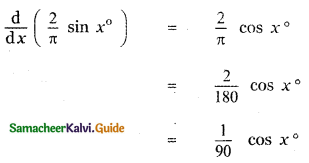
![]()
Question 2.
If y = f(x2 + 2) and f'(3) = 5 , then \(\frac{\mathrm{dy}}{\mathrm{d} x}\) at x = 1 is
(1) 5
(2) 25
(3) 15
(4) 10
Answer:
(4) 10
Explaination:
y = f(x2 + 2)
\(\frac{\mathrm{dy}}{\mathrm{d} x}\) = f’ (x2 + 2) × 2x
\(\frac{\mathrm{dy}}{\mathrm{d} x} / x=1\) = f’ (12 + 2) × 2 × 1
= f’(3) × 2
= 5 × 2 = 10
Question 3.
If y = \(\frac{1}{4}\)u4, u = \(\frac{2}{3}\) x3 + 5, then \(\frac{\mathrm{dy}}{\mathrm{d} x}\) is
(1) \(\frac{1}{27}\) x2 (2x3 + 15)3
(2) \(\frac{2}{27}=\) x (2x3 + 5)3
(3) \(\frac{2}{27}=\) x2 (2x3 + 15)3
(4) – \(\frac{2}{27}=\) x (2x3 + 5)3
Answer:
(3) \(\frac{2}{27}=\) x2 (2x3 + 15)3
Explaination:
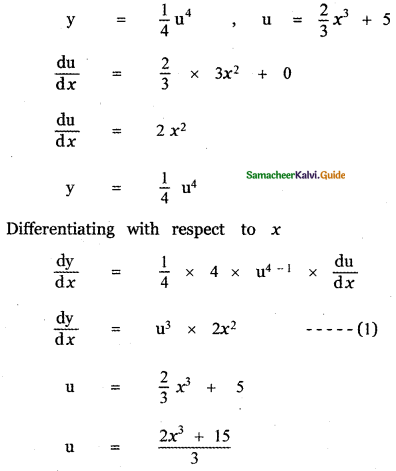
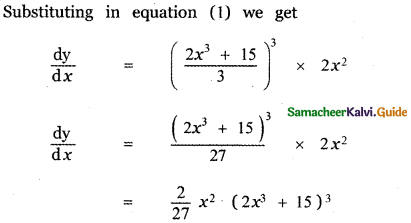
![]()
Question 4.
If f(x) = x2 – 3x, then the points at which f (x) = f’ (x) are
(1) both positive integers
(2) both negative integers
(3) both irrational
(4) one rational and another irrational
Answer:
(3) both irrational
Explaination:
f(x) = x2 – 3x
f’(x) = 2x – 3
f(x) = f'(x)
⇒ x2 – 3x = 2x – 3
x2 – 3x – 2x + 3 = 0
x2 – 5x + 3 = 0
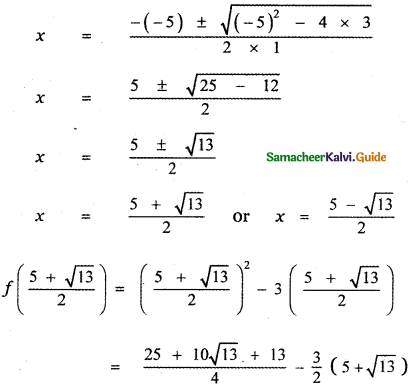
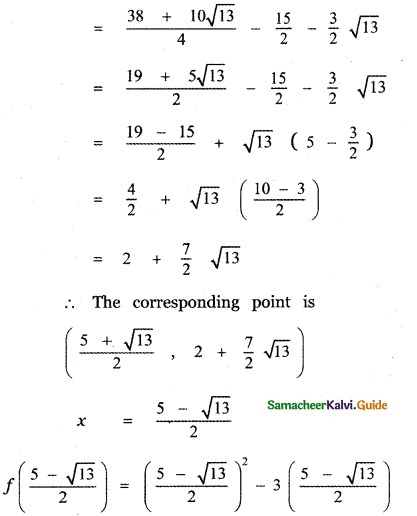
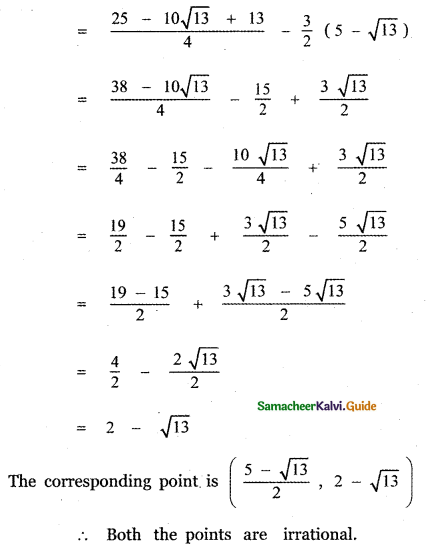
![]()
Question 5.
If y = \(\frac{1}{a-z}\), then \(\frac{\mathrm{d} \mathrm{z}}{\mathrm{d} \mathrm{y}}\) is
(1) (a – z)2
(2) – (z – a)2
(3) (z + a)2
(4) – (z + a)2
Answer:
(1) (a – z)2
Explaination:
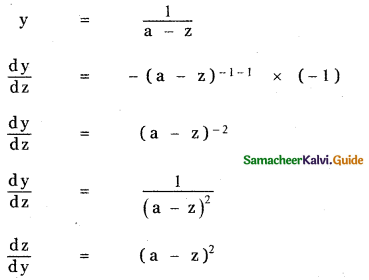
Question 6.
If y = cos (sin x2), then \(\frac{\mathrm{dy}}{\mathrm{d} x}\) at x = \(\sqrt{\frac{\pi}{2}}\) is
(1) – 2
(2) 2
(3) – 2 \(\sqrt{\frac{\pi}{2}}\)
(4) 0
Answer:
(4) 0
Explaination:
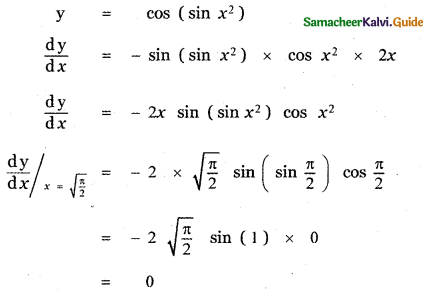
![]()
Question 7.
If y = mx + c and f(0) = f’(0) = 1, then f(2) is
(1) 1
(2) 2
(3) 3
(4) – 3
Answer:
(3) 3
Explaination:
y = mx+c
\(\frac{d y}{d x}\) = m
y = x + c (i.e.) f(x) = x + c
y(a tx = 0) = f(0) 0 + c = 1 ⇒ c = 1
y = x + 1 ⇒ f(x) = x + 1
f(2) = 2 + 1 = 3
Question 8.
If f(x) = x tan-1 x then f'(x) is
(1) \(1+\frac{\pi}{4}\)
(2) \(\frac{1}{2}+\frac{\pi}{4}\)
(3) \(\frac{1}{2}-\frac{\pi}{4}\)
(4) 2
Answer:
(2) \(\frac{1}{2}+\frac{\pi}{4}\)
Explaination:
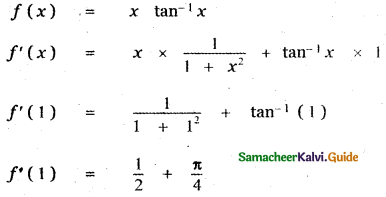
![]()
Question 9.
\(\frac{d}{d x}\) (ex + 5 log x) is
(1) ex . x4 (x + 5)
(2) ex . x (x + 5)
(3) ex + \(\frac{5}{x}\)
(4) ex – \(\frac{5}{x}\)
Answer:
(1) ex . x4 (x + 5)
Explaination:
![]()
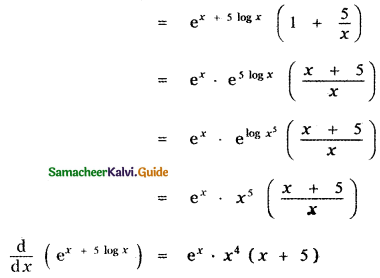
Question 10.
If the derivative of (ax – 5)e at x = 0 is – 13 , then the value of a ¡s
(1) 8
(2) – 2
(3) 5
(4) 2
Answer:
(4) 2
Explaination:
y = (ax – 5)e3x
\(\frac{d y}{d x}\) = y’ = (ax – 5) (3e3x) + e3x (a)
= e3x[3ax – 15 + a]
Given \(\frac{d y}{d x}\) = -13 at x = 0
⇒ [-15 + a] = -13
⇒ a = -13 + 15
a = 2
![]()
Question 11.
x = \(\frac{1-t^{2}}{1+t^{2}}\), y = \(\frac{2 t}{1+t^{2}}\) then \(\frac{d y}{d x}\) is
(1) – \(\frac{\mathbf{y}}{x}\)
(2) \(\frac{\mathbf{y}}{x}\)
(3) – \(\frac{x}{y}\)
(4) \(\frac{x}{y}\)
Answer:
(3) – \(\frac{x}{y}\)
Explaination:
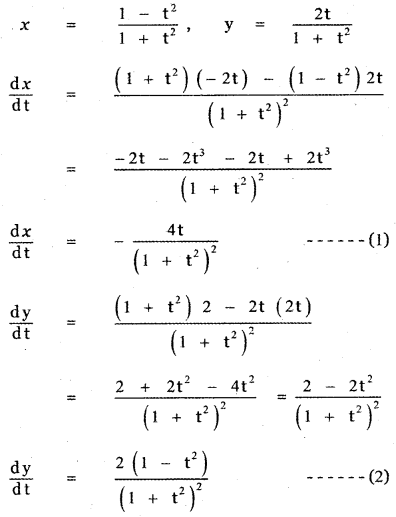
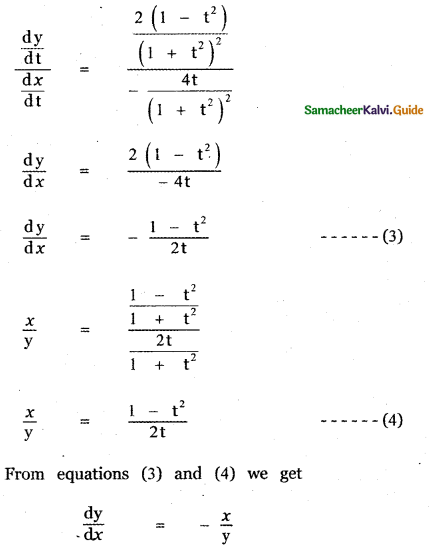
![]()
Question 12.
If x = a sin θ and y = b cos θ, then \(\) is
(1) \(\frac{\mathbf{a}}{\mathbf{b}^{2}}\) sec2 θ
(2) \(-\frac{\mathbf{b}}{\mathbf{a}}\) sec2 θ
(3) \(-\frac{b}{a^{2}}\) sec3 θ
(4) \(-\frac{b^{2}}{a^{2}}\) sec3 θ
Answer:
(3) \(-\frac{b}{a^{2}}\) sec3 θ
Explaination:
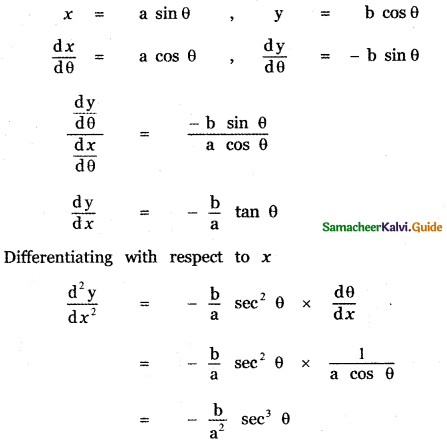
Question 13.
The differential coefficient of log10 x with respect to log10 x is
(1) 1
(2) – (log10 x)2
(3) (log10 x)2
(4) \(\frac{x^{2}}{100}\)
Answer:
(2) – (log10 x)2
Explaination:
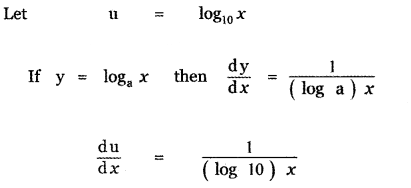
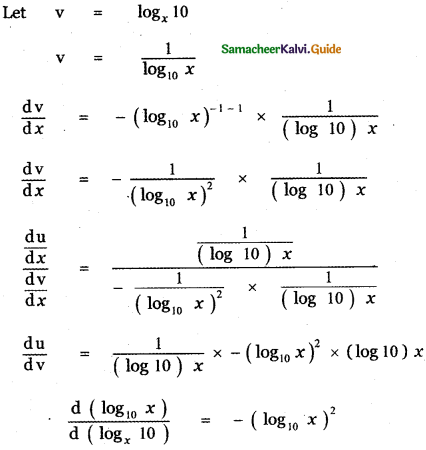
![]()
Question 14.
If f(x) = x + 2 , then f’ (f(x)) at x= 4 is
(1) 8
(2) 1
(3) 4
(4) 5
Answer:
(2) 1
Explaination:
f(x) x + 2
f’ (f(x)) = \(\frac{\mathrm{d}}{\mathrm{d} x}\) (f(x))
= \(\frac{\mathrm{d}}{\mathrm{d} x}\) (x + 2) = 1
Question 15.
If y = \(\frac{(1-x)^{2}}{x^{2}}\), then \(\frac{\mathrm{dy}}{\mathrm{d} x}\) is
(1) \(\frac{2}{x^{2}}+\frac{2}{x^{3}}\)
(2) \(-\frac{2}{x^{2}}+\frac{2}{x^{3}}\)
(3) \(-\frac{2}{x^{2}}-\frac{2}{x^{3}}\)
(4) \(-\frac{2}{x^{3}}+\frac{2}{x^{2}}\)
Answer:
(4) y = \(\frac{(1-x)^{2}}{x^{2}}\)
Explaination:
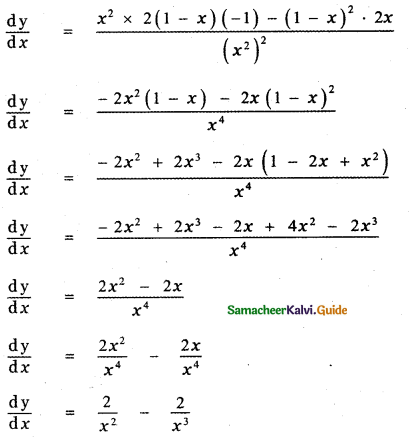
Question 16.
If pv = 81, then \(\frac{\mathbf{d} \mathbf{p}}{\mathbf{d v}}\) at v = 9 is
(1) 1
(2) – 1
(3) 2
(4) – 3
Answer:
(2) – 1
Explaination:
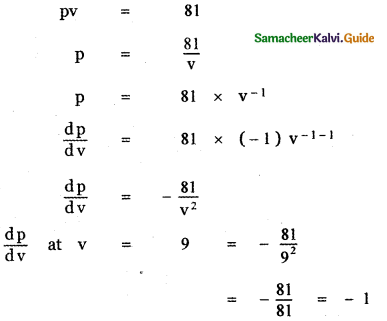
![]()
Question 17.

(1) 0
(2) 2
(3) 3
(4) 4
Answer:
(3) 3
Explaination:
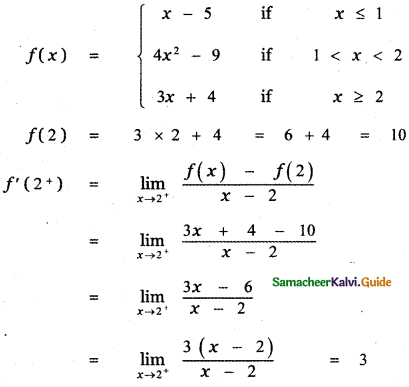
Question 18.
It is given that f’ (a) exists, then

(1) f(a) – af'(a)
(2) f'(a)
(3) – f'(a)
(4) f(a) + af'(a)
Answer:
(1) f(a) – af'(a)
Explaination:
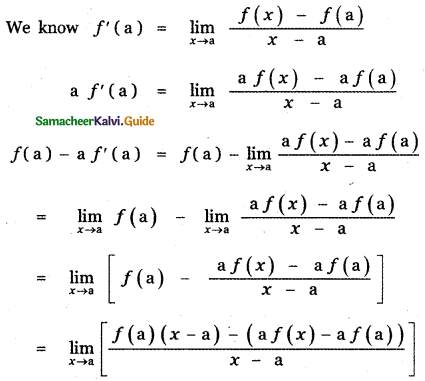
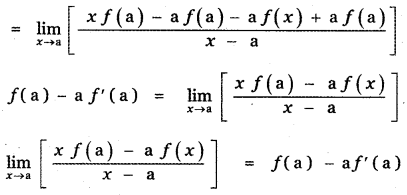
![]()
Question 19.
If f(x) =  then f’ (2) is
then f’ (2) is
(1) 0
(2) 1
(3) 2
(4) does not exist
Answer:
(3) 2
Explaination:
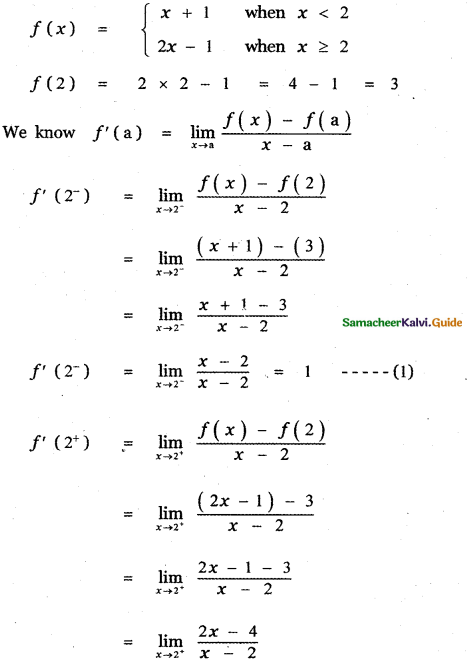

Question 20.
If g(x) = (x2 + 2x + 3) f(x) and f(0) – 5 and ![]() then g'(0) is
then g'(0) is
(1) 20
(2) 14
(3) 18
(4) 12
Answer:
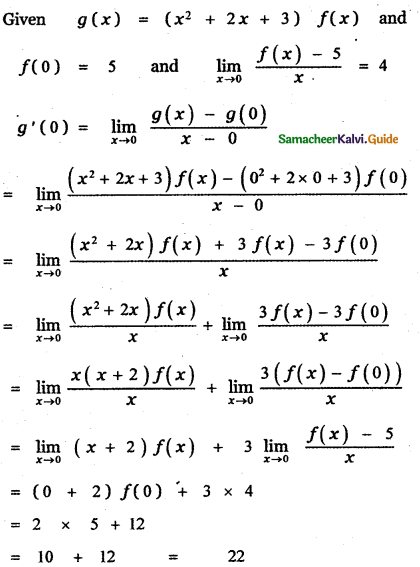
![]()
Question 21.
If f(x) = 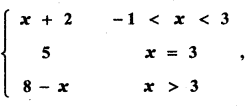 then at x = 3, f'(x) is
then at x = 3, f'(x) is
(1) 1
(2) – 1
(3) 0
(4) does not exist
Answer:
(2) – 1
Explaination:
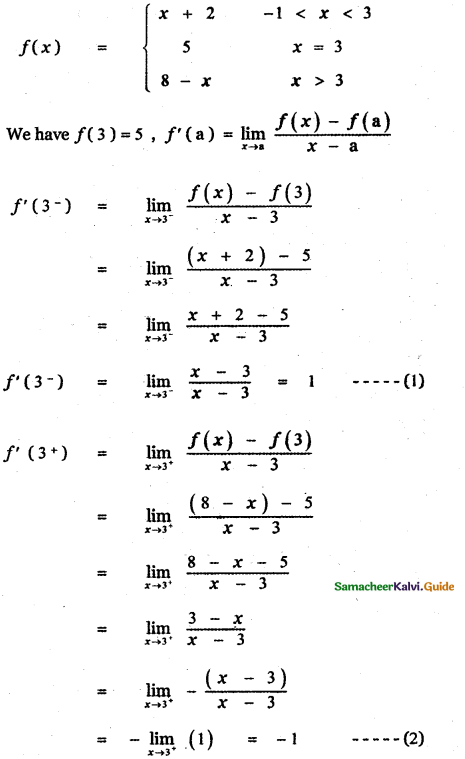
From equations (1) and (2) we get
f’ (3–) ≠ f’ (3+)
∴ limit of f(x) does not exist at x = 3
f’ (x) does not exist at x = 3
Question 22.
The derivative of f(x)= x|x| at x = – 3 is
(1) 6
(2) – 6
(3) does not exist
(4) 0
Answer:
(1) 6
Explaination:
f(x) = x|x|
f(x) = x(-x) ⇒ f(x) = – x2
f ‘(x) = -(2x)
f ‘(-3) = -(2) (-3) = 6
![]()
Question 23.
If f(x) =  then which one of the following is true?
then which one of the following is true?
(1) f(x) is not differentiable at x = a
(2) f(x) is discontinuous at x = a
(3) f(x) is continuous for all x in R
(4) f(x) is differentiable for all x ≥ a
Answer:
(1) f(x) is not differentiable at x = a
Explaination:
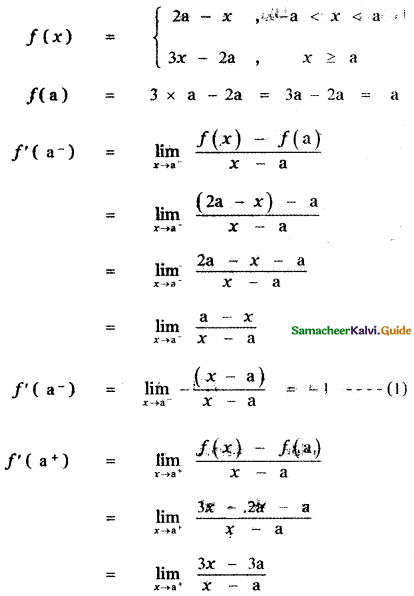

f’ (a+) = 3 ………. (2)
From equations (1) and (2) we get
f'(a–) ≠ f'(a+)
∴ f’ (x) does not exist at x = a
∴ f(x) is not differentiable at x = a
![]()
Question 24.
If f(x) =  is differentiable at x = 1, then
is differentiable at x = 1, then
(1) a = \(\frac{1}{2}\), b = \(\frac{-3}{2}\)
(2) a = \(\frac{-1}{2}\), b = \(\frac{3}{2}\)
(3) a = \(-\frac{1}{2}\), b = \(-\frac{3}{2}\)
(4) a = \(\frac{1}{2}\), b = \(\frac{3}{2}\)
Answer:
(3) a = \(-\frac{1}{2}\), b = \(-\frac{3}{2}\)
Explaination:
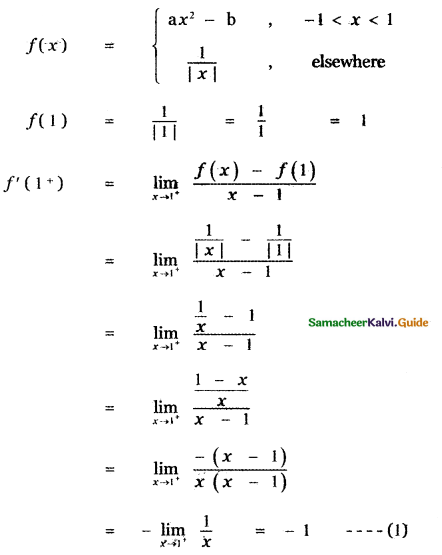
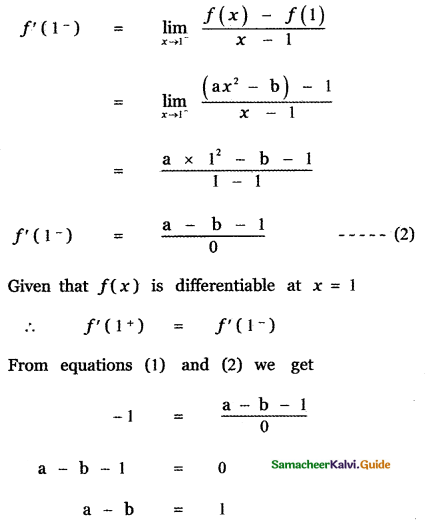

![]()
Question 25.
The number of points in R in which the function f(x) = |x – 1| + |x – 3| + sin x is not differentiable, is
(1) 3
(2) 2
(3) 1
(4) 4
Answer:
(2) 2
Explaination:
f(x) = |x – 1| + |x – 3| + sin x is not differentiable at x = 1, and x = 3